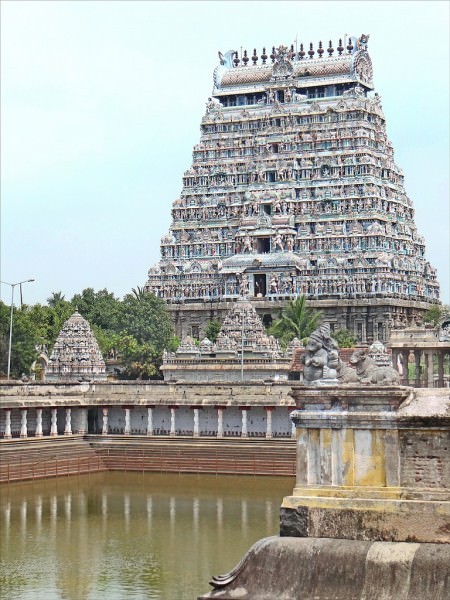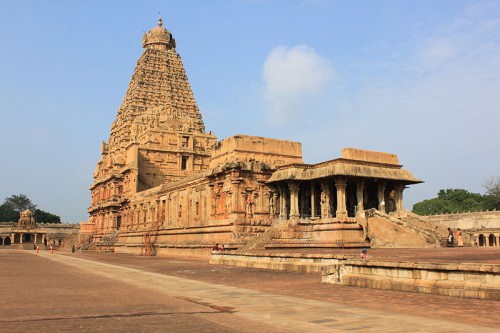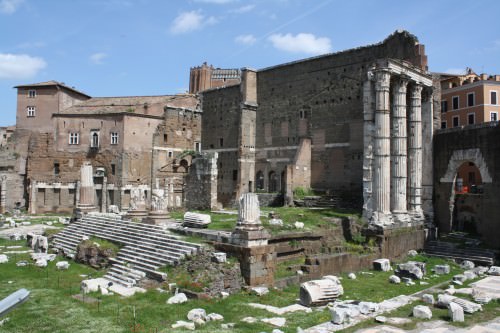Hindu Architecture › Temple of Mars Ultor, Rome » Ancient origins
Articles and Definitions › Contents
- Hindu Architecture › Ancient History
- Temple of Mars Ultor, Rome › Antique Origins
Ancient civilizations › Historical and archaeological sites
Hindu Architecture › Ancient History
Definition and Origins

Hindu architecture evolved over the centuries from simple rock-cut cave shrines to massive and ornate temples which spread across the Indian sub-continent and beyond, forming a canonical style which is still adhered to today in modern Hindu temples across the globe. Essential elements of the style are precise and harmonious geometry when viewed from all four sides and above, the square form and grid ground plans, soaring towers, and elaborate decorate sculpture which includes gods, worshippers, erotic scenes, animals, and floral and geometric patterns.
BEGINNINGS & PURPOSE
From the 1st century CE a new type of worship known as Bhakti or devotional Hinduism spread across the Indian sub-continent, and the old Vedic gods were replaced in importance by deities like Shiva, Vishnu, Krishna, Brahma, and Devi.These gods would become the central figures of Hinduism and their worship required temples where the devoted could offer their thanks and reveal their hopes for a better life.
Buildings were constructed which could house a sacred symbol of a particular god, which could be decorated with sculptural figures of them so recalling episodes from their mythological adventures, and which provided a space for worshippers to leave offerings and perform rituals such as bathing and dancing by professional female dancers ( devadasi ). The temple was considered the dwelling place of a particular god ( devalaya ). It was, therefore, a sacred place ( tirtha ) where heaven and earth meet and, as a god's home, it must be a suitably splendid palace ( prasada ). The needs of the god would, additionally, be supervised by a dedicated body of priests ( pujaris ) who attended the temple.
TEMPLES WERE BUILT TO HOUSE A SACRED SYMBOL OF A PARTICULAR GOD AND WERE DECORATED WITH SCULPTURAL FIGURES RECALLING EPISODES FROM MYTHOLOGY.
Hindus need not attend regular services, but an occasional walk around the temple interior (circumambulation), known as pradaksina and done in a clockwise direction, was considered auspicious. Further, they could say prayers, look at the god's representation – a specific act of piety known as darsan – and leave offerings of food and flowers ( puja ). Temples, inevitably, became the very centre of a community and, accordingly, their upkeep was guaranteed by land grants and endowments from the ruling class, as indicated by inscriptions on many temples.
EARLY INFLUENCES
Influenced by early Buddhist structures such as the stupa, the first Hindu temples were built from rock-cut caves and repeated the idea of relief panels and the decorative gavaska window form. Then, with the arrival of Gupta architecture in the 4th to 5th century CE, the first free-standing Hindu temples were constructed with features such as towers and projecting niches.
The first materials used were wood and terracotta, but architects gradually moved on to brick and stone, especially sandstone, granite, schist, and marble. No mortar was used in the older temples and so precise cutting of dressed stones was required.Outstanding examples of influential cave temples include those at Udaigiri in Malwa and date to the 5th century CE. Early free-standing temples survive at Deogarh and include the 6th century CE Dasavatara temple dedicated to Vishnu.

Durga Temple, Aihole
HINDU TEMPLE FEATURES
The Hindu temple ( mandir ) is laid out according to the eight cardinal directions, and a god representing each one ( dikpala ) may sometimes be represented in sculpture on the temple's exterior. Built on an elaborately carved platform ( adhisthana ), the temple is often referred to in ancient Hindu texts on architecture (the Vastu Shastras ) as the sacred mountain Meru or Kailasa, the dwelling of Shiva in the Himalayas. Indeed, seen from afar, and especially from above, many Hindu temples, with their multiple towers, appear very much like a mountain mass. The 11th century CE Kandariya Mahadeva temple at Khajuraho and 12th century CE Rajarani temple at Bhubaneswar are outstanding examples of this effect.
The most important part of a Hindu temple is the garbhagriha (translated as 'womb-chamber'), which is a small window-less shrine room located at the very heart of the temple. Within, a symbol or representation of a specific god was placed, for example, the linga (phallus) for Shiva. Worshippers consider that energy flows out in all directions from the garbhagriha, and this is reflected in the architecture of the surrounding parts of the temple. For example, on three sides temples have blind doors which symbolically allow the deity's energy to leave the inner garbhagriha. These portals ( ghana dvara ) may also act as secondary niche shrines for the deity too.

Gopura & Nataraja Temple, Chidambaram
Early temples consisted of only a garbhagriha, but over time additions were built and copied across temple sites to create, by the 10th century CE, a canonical architectural style. The most obvious of these features were a portico entrance ( ardhamandapa ) and pillared hall ( mandapa ) which led to the garbhagriha – features which developed in the Deccan from the 8th century CE. Even more impressive, above the garbhagriha a huge corbelled tower was constructed, the sikhara. One of the earliest examples incorporating these features can be found in Aiholi and the 8th century Durga temple, whilst one of the most ornate is the 12th century CE Nataraja Temple at Chidambaram in the Tamil Nadu.
NAGARA & DRAVIDA TEMPLES
Architecture evolved slightly differently in different regions, such as the distinct features of Orissa, Kashmir and Bengal temples, but two general types are identified as the Nagara (North) and Dravida (South) styles. The sikhara tower in Nagara temples have a sloping curve as they rise, have decorative arches known as gavakshas, and are topped by an amalaka – a large fluted stone disk – and also a small pot and finial. The walls of Nagara temples present a complex exterior of projections (known as ratha and ultimately there would be seven on each side) which create many recesses. In contrast, Dravida towers (known separately as vimana ) are more dome-like with cornices, and they are topped by another smaller dome. The exterior walls of Dravida temples have regular entablatures which often contain sculpture. Southern Indian temples can also have a ritual bathing tank or pool ( nandi mandapa ), may have a barrel-vaulted ( shala ) roof, and are typically enclosed within a walled courtyard with a gate ( gopura ) which over time would become even more massive and ornate than the temple itself.The 11th century CE Brihadishvara Temple complex at Tanjavur is a wonderful example which incorporates all of these features.

Brihadishvara Temple, Tanjavur
CONCLUSION
Beginning with humble caves and squat flat-roofed temples, Hindu architecture, then, evolved over the centuries and, despite some regional variation, arrived at a standard arrangement which involved a huge walled complex with massive decorative gateways giving entrance to a sacred space of lesser shrines dominated by the main temple and its monumental series of towers. The design has become so standard that it is copied even today in temples across the world from New Delhi to Malibu, California.
Temple of Mars Ultor, Rome › Antique Origins
Ancient Civilizations
The Temple of Mars Ultor stands in the Forum of Augustus in Rome and was built to commemorate Augustus' victory in 42 BCE at the Battle of Philippi over the assassins of Julius Caesar. The building became the place where important military decisions were taken and a site of several state ceremonies with a military connotation.

Temple of Mars Ultor, Rome
THE FORUM OF AUGUSTUS
The Forum of Augustus originally covered some 8,000 square metres and was built next to Caesar ’s Forum. Later, it would be bordered on the left side by Trajan ’s Forum and on the right by Nerva ’s Forum to create the complex known today as the Imperial Fora. Dominating this civil space created by Augustus was the temple dedicated to Mars, the god of war in his guise as 'the Avenger' (Ultor).
AUGUSTUS DECREED THAT THE TEMPLE SHOULD BE THE MEETING PLACE FOR THE SENATE WHEN DECISIONS OF WAR WERE TAKEN.
The temple was finally inaugurated (although still not quite finished) in 2 BCE and it came to function as the focal point of Roman military strategy. For example, Augustus decreed that it should be the meeting place for the Senate when decisions of war were taken. The temple was also the place where young Roman males were ceremoniously given their adult toga, thus becoming eligible for military service, and it was the official departure point for commanders embarking on military service in the empire.
The temple was designed to reflect the style of the nearby Temple of Venus in Caesar's Forum and so create an architectural harmony. There was one notable difference, though, in that the temple of Mars Ultor was made one and a half times bigger.The temple, typical of Roman architecture, was built on a raised platform and entranced via steps which were originally flanked by fountains, once again, in imitation of the arrangement outside the Temple of Venus.

Forum of Augustus, Rome
TEMPLE EXTERIOR
The exterior of the temple was constructed using the Italian white Luna marble from Cararra. The Corinthian columns were 17.8 m high and arranged in a row of eight on the façade and eight down each side, three of which are still standing today. The flooring was laid with a mixture of coloured marble - yellow Numidian, purple Phrygian and Lucullun red and black. The interior cella had two sides of columns, probably also in purple marble, and in the wall behind these there were purple Phrygian pilasters on either side of niches which contained statues. The column capitals and those of the pilasters were especially interesting as, instead of the usual volutes, they had representations of Pegasus who was thought to carry the thunderbolts of Zeus, the god's traditional weapons. The interior ceiling was composed of coffered slabs embellished with gilded rosettes.
STATUE OF MARS
The centre-piece of the whole temple was a huge marble statue of Mars who resided in the apse of the cella ahead of five Egyptian alabaster covered steps and surrounded by the legionary standards which the Parthians had taken but which, following Roman victory, were recaptured and restored to Rome. The torso of this statue may well be the one now in the Capitoline Museums of Rome with the head, arms and legs having been restored.
LATER ADDITIONS & RE-USE
Behind the temple stands a 30 m high tufa wall which is topped with white travertine. It was constructed to separate the Forum from the hill residences behind it and to act as a firewall should a fire start in this densely-populated area of the city. In the 1st century CE Tiberius added two arches to the temple sides in honour of his two sons Drusus the Younger and Germanicus but these have now been lost except for the foundations of one. In the 2nd century CE Hadrian repaired parts of the building but from the 5th century CE the building went into decline and blocks began to be re-used in other building projects. From the 12th century CE soil was added to the site and the area used for agriculture, however, as the drains were then blocked, a marsh formed until the area was drained in the 16th century CE.
LICENSE:
Article based on information obtained from these sources:with permission from the Website Ancient History Encyclopedia
Content is available under License Creative Commons: Attribution-NonCommercial-ShareAlike 3.0 Unported. CC-BY-NC-SA License